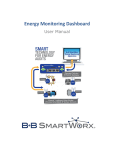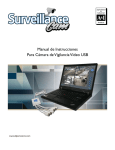Download CheckVideo Gateway Installation guide
Transcript
CheckVideo Gateway for Mobile Broadband Networks Installation Guide Welcome CheckVideo® products allow for cloud-based, intelligent vide surveillance and alarm verification in virtually any indoor, outdoor or remote location. They enhance security and improve business operations with real-time event detection, sending alerts to emails, smartphones or a monitoring service for immediate response. The CheckVideo Gateway for Mobile Broadband Networks is a device that applies video intelligence to video from cameras and sends alerts over the Sprint 3G mobile network. This guide covers installation, registration, and configuration of the CheckVideo Gateway (referred to as a “CheckVideo device” in the CheckVideo Portal). Once you complete the process, you will have an active system tailored to your specific needs. For more information on using CheckVideo, please refer to the CheckVideo Online Help. After registering your CheckVideo Gateway you can view the Online Help by signing in at portal.checkvideo.net, then going to the Support tab. Table of Contents Step 1 Review Requirements Step 2 Camera Placement Step 3 Setting Up the Gateway for Mobiel Broadband Networks Step 4 3G Signal Strength Verification Step 5 Account Registration Step 5-1 Register Primary User Step 5-2 Define Notification Methods for Primary User Step 5-3 Define Billing Preferences (Professional Service) Step 5-4 Review License Agreement (Professional Service) Step 6 Add CheckVideo Gateway Step 6-1 Configure Live Video for Remote Viewing Step 6-2 Update Firmware (if necessary) Step 7 Configure the CheckVideo Device Step 7-1 Select Camera Step 7-2 Configure Events (Zone Setup) Step 7-3 Configure Events (Schedule Configuration) Step 7-4 Define Notification Methods by Camera (optional) About the Dashboard Helpful Hints Appendix: Adding Additional Storage for DVR Recording CheckVideo Gateway for Mobile Broadband Networks Installation Guide Page 2 3 4 5 6 7 8 9 10 11 12 13 14 15 17 18 19 21 22 23 page 1 Step 1 Review Requirements Before you begin, if this CheckVideo device will be monitored by a central station, please contact the central station for a username and password on their existing CheckVideo account. If this device will be self-monitored, you will be creating a CheckVideo account in Step 5. Confirm that you have the equipment you will need. Included in the CheckVideo Gateway for Mobile Broadband Networks Kit: • CheckVideo Gateway for Mobile Broadband Networks with Franklin® 3G S600C Module • CheckVideo Gateway power supply (9V, 1.66A) • Franklin 3G Module power supply (12V, 1 A) • Franklin 3G Module antennas (2) • USB 2.0 Cable • Sticker displaying MEIDs for the Franklin 3G Module and Serial Number (SN) for the CheckVideo Gateway (see page 11) • 8 pin Phoenix connectors (optional, for digital input/output contacts) Required, but not included: • Sprint 3G Network Access. Signal strength greater than -84 to -86 dBm (e.g., -85 dBm, -50 dBm, etc.) is required to receive firmware updates and stream live video • Up to four fixed, analog NTSC/PAL cameras • Computer with Microsoft Internet Explorer or Mozilla Firefox (required for initial registration and configuration) Optional: • Monitor for viewing Received Signal Strength during setup. This can be a TV connected to a CheckVideo Gateway monitor connector with a BNC to RCA cable. • 8 pin Phoenix connectors for digital input/output contacts (included in kit) • Uninterruptible Power Supply (UPS) • USB storage device for expanded storage (up to 1 TB). This will require an externally-powered USB hub. If using a UPS power source, the same power source should be used for the entire CheckVideo solution (i.e., the CheckVideo Gateway, USB hub, Franklin 3G Module, storage device, and cameras). For more information, see the Appendix on pages 23-24. CheckVideo Gateway for Mobile Broadband Networks Installation Guide page 2 Step 2 Camera Placement This checklist summarizes the best practices for placing cameras. You can use this checklist to conduct a survey of your setup and determine where to place cameras. DESCRIPTION CAMERA PLACEMENT The camera should be installed 8 to 20 feet above the ground and tilted downward at an angle between 15° and 45° (Figure 1A). It should be positioned 10 to 40 feet from people, or 20 to 60 feet from vehicles. DIRECTION OF MOTION People and vehicles should normally move from left-to-right or right-to-left in the camera view (Figure 2A), not directly toward or away (Figure 2B). IMAGE SHARPNESS Maintain a clear camera image. Don’t point the camera through a window pane or screen, and avoid placing it in conditions that would cause the camera lens to fog up or accumulate water droplets. CAMERA ORIENTATION Objects in the camera view should appear upright. In other words, the camera should not be rotated clockwise or counterclockwise. SECURE MOUNTING The camera should be securely mounted. ADEQUATE, EVEN LIGHTING Lighting should be constant and sufficient to read a newspaper in the camera view where people or vehicles appear. PHYSICAL OBSTRUCTIONS Physical obstructions or sources of constant motion (e.g., moving doors, flags waving in the wind, etc.) are not in the camera view. REFLECTIONS, GLARE, OTHER LIGHTING EFFECTS Reflective surfaces (e.g., mirrors, window panes, water, or polished floors) or bright lights (e.g., headlight glare, direct sunlight) are not directed at the camera. ü For more information and specific examples, go to www.checkvideo.com/support/ and review the CheckVideo Camera Placement Guide. CheckVideo Gateway for Mobile Broadband Networks Installation Guide A MORE EFFECTIVE - Cameras are at 15 to 45 degree downward tilt B LESS EFFECTIVE - Cameras are directly overhead (90 degrees) or parallel to (0 degrees) the target Figure 1 Camera Angle A MORE EFFECTIVE - A target traveling from left to right B LESS EFFECTIVE - A target traveling directly toward the camera Figure 2 Target Direction of Motion page 3 Step 3 Setting Up the Gateway for Mobile Broadband Networks 1. Attach the antennas to the Franklin Module. The antenna with the white stripe at the base should be on the left when looking at the front of the device (see Figure 3). 2. Extend the tips of the antennas outward from the Module. There should be a good distance between the tips (see Figure 4), but not so great that they are flat). White Stripe Franklin Module 3. Connect the USB cable between the USB port on the Gateway back panel and the USB port on the front of the Franklin Module (see Figure 5). Note: The Gateway has 32 GB of onboard storage that it uses to continuously record DVR video. You can add additional storage through an external storage device attached to a USB hub. See the Appendix for more information. 4. Connect each camera’s video cable to a camera port on the back of the Gateway. Figure 3 Antenna positions Figure 4 Antennas spread outward 5. Plug in the power to the Franklin Module (12V, 1A). IMPORTANT: Do not use the Gateway’s power supply (which is larger) to power up the Franklin module. Doing so may seriously damage the module. 6. Plug in the power to the Gateway (9V, 1.66 A). 7. Wait a few minutes for the power light on the front of the Gateway to flash rapidly. 8. When the flashing slows to one second per pulse, proceed to the next page. Note: Although designed to operate over a cellular network, the Gateway can also connect to the Internet via its Ethernet port. If an active Internet connection is established over Ethernet, the device will use this connection and not 3G. Figure 5 USB Port Locations CheckVideo Gateway for Mobile Broadband Networks Installation Guide page 4 Step 4 3G Signal Strength Verification (optional) Make sure there is an adequate 3G signal to your Gateway. You can see the precise signal strength by attaching a monitor to the Monitor output on the Gateway back panel (Figure 6). This can be a TV connected to a CheckVideo Gateway monitor connector with a BNC to RCA cable. It may take up to five minutes for the Received Signal Strength Indication (RSSI) to be displayed on your monitor (see Figure 7). The 3G signal strength should be greater than -84 to -86 dBm. Remember that -86 is a negative value, so -85 would be a better signal strength than -86, -50 would be much better than -85, etc. Note that because the RSSI text is white, it may not appear clearly for camera views with a light background. In such cases, you might want to temporarily disconnect the camera attached to the “Cam 1” camera port. Monitor Output Figure 6 Monitor output on CheckVideo Gateway Tips: • Make sure that the tips of the antennas are extended outward from the Module. • Remove any obstructions immediately around the antenna. • You can use a Sprint 3G mobile device to assess relative signal strength within your facility. However, any signal strength displayed on a mobile device won’t necessarily be valid for what the CheckVideo Gateway would receive at that spot. • When necessary, move the Gateway to an area with an adequate signal strength, or consider the use a 3G signal-boosting antenna or amplifier. • If the message on the monitor indicates that the cell service is not active, call Support. • Cellular signal strength will vary over time. Additionally cellular network capacity will vary over time. These considerations must be taken in to account when deploying a mobile broadband solution. Note: You will not see the RSSI displayed on your Monitor output if you have the Franklin Module and an external storage device concurrently connected to your Gateway with a USB hub. The process for connecting an external storage device is provided in the Appendix on page 22. CheckVideo Gateway for Mobile Broadband Networks Installation Guide Figure 7 RSSI displayed via Monitor output page 5 Step 5 Account Registration Using a Web browser, go to the CheckVideo Dashboard Login page at portal.checkvideo.net (Figure 8). If you already have an existing CheckVideo account and need to register additional CheckVideo devices, sign in and click on Devices > Add a Device. See Step 6 on page 11 for information on adding devices. If you are new to CheckVideo and your CheckVideo device will be monitored by a central station, please contact the central station for a CheckVideo username and password on their existing account. If you are new to CheckVideo and your CheckVideo device will be self-monitored, click the Start here link (Figure 9) to create a user account. Figure 8 The Log In to CheckVideo box Figure 9 Page link that will direct you to creating a new account CheckVideo Gateway for Mobile Broadband Networks Installation Guide page 6 Step 5-1 Register Primary User The Primary User is the owner and main contact for this CheckVideo account. This person defines system preferences, including access for additional users to the same CheckVideo system. On the Initial Logon and Registration Wizard page, User Information section, enter the requested information in each field (Figure 10). Some fields to pay particular attention to include: • User Name: Enter a valid email address as the primary email address that you want associated with your CheckVideo account. This email address is used to log into your account at portal.checkvideo.net. • Password: Enter an alphanumeric password between 6 and 12 characters long After initial registration, you can update your password at any time via your User Profile page. • Time Zone: Select the time zone you prefer as the default time zone for all CheckVideo devices registered to this account. All event configuration options and event notifications are displayed according to the time zone you select. • Challenge Questions: Select challenge questions and answer them in a way that you are sure to remember. Challege questions are used to help you retrieve your login information at a later time. After you have completed the required information fields, click the Define Notification Methods button (Figure 11) to proceed to the next step in the registration process. Figure 10 Initial Logon and Registration Wizard page, User Information section Figure 11 Installation Wizard button that will direct you to the next step CheckVideo Gateway for Mobile Broadband Networks Installation Guide page 7 Step 5-2 Define Notification Methods for Primary User On the Initial Logon and Registration Wizard page, Define Notification Methods section (Figure 12), you can define Primary User notifications. • The email address entered in the User Information section automatically show in the Email 1 field. One address is automatically selected as the default for notifications. To send notifications to a mobile phone, the address format varies by carrier (e.g., a Verizon Wireless address might be [email protected]). Also, the domain name may be different for SMS and MMS messages. Figure 13 shows SMS and MMS domain names for several major wireless providers in the U.S. Refer to your carrier’s support documentation or web site for more information. • For each email, select one of the following Notification Formats: - “Text” means that alert details are transmitted via a text message. - “ Text with hyperlink to video” means the text message includes a link on the CheckVideo Portal where you can view a 10 second event clip. These clips cannot be displayed on mobile phones. Note that if you click Test to test this option, clicking the hyperlink opens a new tab in the browser you are using to view the Registration page. Figure 12 Initial Logon and Registration Wizard page, Define Notifications section Provider SMS MMS AT&T [mobile number]@txt.att.net [mobile number]@mms.att.net e.g., [email protected] e.g., [email protected] - “ Text with attached still image” means the message includes an attached graphic file with a snapshot of the event in progress. Sprint [mobile number]@messaging.sprintpcs.com [mobile number]@pm.sprint.com e.g., [email protected] e.g., [email protected] - “ Text with attached video clip” means a message with an attached ten second video clip. You will also need to choose the maximum acceptable video resolution for the device viewing the video clip. T-Mobile [mobile number]@tmomail.net [mobile number]@tmomail.net e.g., [email protected] e.g., [email protected] Verizon [mobile number]@vtext.com [mobile number]@vzwpix.com e.g., [email protected] e.g., [email protected] Virgin Mobile [mobile number]@vmobl.com [mobile number]@vmpix.com e.g., [email protected] e.g., [email protected] Once you have defined an email address and associated it with a Notification Format, click the Test button to confirm you can receive alerts as expected. If the test fails, try another Notification Format. After you have completed the required information fields, click the Set up Billing button (Figure 14) to proceed to the next step in the registration process. Figure 13 E-mail address format for major U.S. wireless providers Figure 14 Installation Wizard button that will direct you to the next step CheckVideo Gateway for Mobile Broadband Networks Installation Guide page 8 Step 5-3 Define Billing Preferences (Professional Service only) On the Initial Logon and Registration Wizard page, Billing section (Figure 15), you can choose your CheckVideo Service Option and method of payment. Two service options are available: • Professional service is designed for individual intelligent remote video monitoring. CheckVideo analyzes the video for events and sends those real-time video alerts to you and/or your customers for self monitoring. Professional service includes 500MB of alarm clip storage per non-HD device and 10 alerts per camera per day, pooled across all devices on the account. • Central service is for CheckVideo integration with central station automation software. It provides intelligent video alarm verification to third party monitoring companies. The Central service level allows for integration with alarm panels. Central service is for CheckVideo integration with central station automation software. Real-time video alarms are sent directly to the central station interface for assessment and response. Upon the registration of your first CheckVideo device, you will receive two months of Professional service at no cost. After the two month promotional period, your credit card will be charged monthly based on the number of active devices on the CheckVideo portal. Fill in your billing information and click the Authorize Service Fees button (Figure 16). You’ll see a screen that summarizes your monthly charges (Figure 17). Figure 15 Initial Logon and Registration Wizard page, Billing Preferences section Figure 16 Installation Wizard button that will direct you to the next step Click the Confirm Billing button to approve the charges and proceed to the next step in the registration process. Figure 17 Authorize Service Fees section CheckVideo Gateway for Mobile Broadband Networks Installation Guide page 9 Step 5-4 Review License Agreement (Professional Service only) After the account registration process, review the CheckVideo License Agreement (Figure 18). Enter the contact information for both an administrative and technical contacts. Select all of the options that describe your relationship with CheckView: • Equipment Distributor: Mark this option if you intend to purchase and resell CheckView equipment. • Software Services Distributor: Mark this option if you plan to purchase and resell access to CheckView software services. • End User Agreement: Mark this option to use the CheckVideo hardware and/ or software services. Mark that you have read and agree to all terms and conditions (Figure 19). Click the Yes, I Agree button (Figure 20). Note: If using Internet Explorer 8 in compatibility mode and the License Agreement buttons won’t submit the form, click the “broken page” icon on the toolbar to turn compatibility mode off and then resubmit the License Agreement. Proceed to Step 6 to add your CheckVideo device. Figure 18 CheckVideo License Agreement Figure 19 Check this box to agree to the terms and conditions Figure 20 Installation Wizard button that will direct you to the CheckView Portal CheckVideo Gateway for Mobile Broadband Networks Installation Guide page 10 Step 6 Add CheckVideo Gateway n the CheckVideo Dashboard, click Devices > Add a Device to register your O CheckVideo device. Enter the serial number (located on the bottom of the CheckVideo Gateway) into the Serial Number field (Figure 21). Note: The name of the physical location for a CheckVideo device is recommended (e.g. “Office Camera”). You can change this name later. Click the Test Device button. • If the test is successful, you will receive a Congratulations message (Figure 22). The CheckVideo Gateway lights should stop blinking and the power light should remain green, confirming that communication between the CheckVideo Gateway and CheckVideo Portal has been established. • If the test fails, you will be presented with a web page containing a series of questions designed to help you identify the potential cause and troubleshoot the situation. If necessary, contact Support. Once you have completed a successful CheckVideo device test, continue with device registration by clicking the “Next I want to” buttons. Note: The device is shipped with a sticker with two “MEID” numbers and the same CheckVideo Serial Number that you use to register the CheckVideo Gateway. The MEIDs are for the Franklin Module, and could be needed when troubleshooting an issue with cellular connectivity. Do not discard this sticker. Instead, we recommend you affix it to the Franklin Module or some other surface. CheckVideo Gateway for Mobile Broadband Networks Installation Guide Figure 21 Device Serial Number Figure 22 Congratulations message, displayed upon successful CheckVideo device test page 11 Step 6-1 Configure Live Video for Remote Viewing n the CheckVideo Dashboard, click Devices > Remote Video Setup O to configure viewing live or recorded video from any computer with broadband Internet access. CheckVideo automatically displays networking information about your device. To allow you to stream live or DVR video from the CheckVideo device to remote users using the CheckVideo portal, enter any value between 9000 and 65535 in the Device Port Number field. In the example in Figure 23, the port assignment is 27129. Click the Save button. Note: If your system includes more than one device, select each device from the System Map to assign a port number to the device. Note: Figure 23 Remote Video Setup page When operating over the 3G network, you don’t need to set up port fowarding to enable remote video. If the 3G connection is used as a failover for an Ethernet connection, you will be required to set up port forwarding. For information, please refer to the CheckVideo Online Help. CheckVideo Gateway for Mobile Broadband Networks Installation Guide page 12 Step 6-2 Update Firmware (if necessary) After adding the device, the Device Update page appears prompting you to select your device, click the device name. CheckVideo verifies the device firmware is up-to-date. This process may take a few moments. Once complete, you will see a confirmation message (Figure 24). Click the Update button to start the firmware upgrade. Note: For the device firmware update to be successful, it is important that the Gateway is receiving an adequate signal (see page 5). Figure 24 Device Update page: Device status CheckVideo Gateway for Mobile Broadband Networks Installation Guide page 13 Step 7 Configure the CheckVideo Device Now you’re ready to configure your CheckVideo device. This process enables you to define the events you want CheckVideo to look for. A wizard will guide you through the next steps. Simply follow the orange buttons. From the CheckView Dashboard, click Device > Configure Device. On the Configure Device page, the Select Device section (Figure 25), should display your device name. Note: If you wish to change the name of the device, enter the new name in the Update Device field and click the Update Now link. Figure 25 Configure Device page, Select Device section The page should automatically display the next section. If not, click the Select my Camera button when you are ready to proceed to the next step (Figure 26). Figure 26 Installation Wizard button that will direct you to the next step CheckVideo Gateway for Mobile Broadband Networks Installation Guide page 14 Step 7-1 Select Camera In the Configure Device page, Select Camera section (Figure 27), select and configure your cameras. This page may require you to install Adobe® Flash® Player to see the camera image. To enable this feature: • Click the Get Flash link that appears where the camera view should be. • Follow the prompts to install Adobe Flash. Select the camera you wish to configure. An image from the camera, also called the ‘field of view’, should appear in the Viewer window. If a camera image does not appear, click the Refresh Image button. In some instances, it can take up to two minutes for a new image to appear. Once you obtain a field of view, use this image as a reference to readjust the camera to a more desirable view, if necessary. Refer to the CheckVideo Camera Placement Guide for guidelines on positioning your camera. N ote: If you move or reposition a camera, you must use the Refresh Image feature to capture the new field of view and ensure your saved preferences remain unchanged. CheckVideo Gateway for Mobile Broadband Networks Installation Guide Figure 27 Configure Device page, Select Camera section page 15 Step 7-1 Select Camera (continued) You can also name a camera to further customize your CheckVideo Portal and notifications. Give each camera a name that has meaning to help you remember its location or field of view (e.g. Main Suite, Elevators, etc.) as shown in Figure 28. The Advanced Configuration button opens the Advanced Configuration screen, where you can access numerous tools for customizing CheckVideo for a particular camera view. As a rule, you should not adjust these settings unless you’ve begun using the product and need to improve the system performance for a particular camera. Refer to the CheckVideo Online Help for detailed instructions on how to make Advanced Configuration changes. Click the Configure Events button (Figure 29) to continue. Figure 28 Configure Device, Select Camera section Figure 29 Installation Wizard button that will direct you to the next step CheckVideo Gateway for Mobile Broadband Networks Installation Guide page 16 Step 7-2 Configure Events (Zone Setup) On the Configure Device page, Configure Events section, you determine how CheckVideo monitors for events. First, determine what type(s) of event you want CheckVideo to look for. If you choose Person or Vehicle, your camera should be positioned so that these objects remain in the camera’s view for the entire Duration of the event. If you choose Motion, you’ll decrease the chance of missed events, but you may also increase the likelihood of receiving unwanted notifications. Then, use the “Zone” feature to define the areas you wish to monitor. A zone defines the boundaries of the monitored area within a camera’s field of view. • T o create a zone, click the Draw/Edit radio button next to the appropriate event type (Figure 30). Then use your mouse to draw the zone by clicking the left mouse button wherever you want to define a corner of the zone. • The first point you create will be colored green; other points will be blue. • hen drawing the zone, keep in mind that it should cover the entire area where W you would like an object to be detected and should not cover any area where you do not wish to detect activity. In the example in Figure 31, the zone covers the entrance of an office suite. The glass door leading into the zone is excluded, to avoid detection of reflections from the glass or objects on the other side of the door. • T o delete a point after you’ve placed it, click it. To move a point after you’ve placed it, click and drag it to the desired new location. To create a new point between two existing points, SHIFT+click the point that was placed first. • licking the green point in the zone or the Draw/Edit option for another zone C completes the zone. A completed zone displays a single red point at the zone’s start point (Figure 31B). • If you want to completely erase a zone you’ve created and start again, click the red point. If you want to just edit the dimensions of the zone, SHIFT+click the red point. CheckVideo Gateway for Mobile Broadband Networks Installation Guide Figure 30 Configure Events section, Person selected for Zone Setup A A zone, defined by eight end points (first point is green; other points are blue) B A completed zone (start point is colored red) Figure 31 Drawing a zone page 17 Step 7-3 Configure Events (Schedule Configuration) Once you have set up your zone, use the Schedule Configuration section to determine when and under what conditions the system reports events. First, select the Event type (Person, Vehicle, or Motion). A zone must have been created before that type of event can be detected. Select External Trigger if you want the CheckVideo device to generate an event when an external sensor is triggered (see the Online Help for more information on External Triggers). Then, select the Day of Week [day], Start [time] and End [time] that an event would occur. If you are monitoring for the same type of event on multiple days of the week, you can select Every Day, Weekdays, or Weekend. In the example in Figure 32, the user wants to monitor for people at any time of day (12:00 AM to 11:59 PM) on weekends. uration: Select the amount of time that an object must remain in the selected D zone before CheckVideo creates an event and notifies you. In the example in Figure 34, the user wants to be notified on Sunday if a person has been in the zone for at least 2 seconds. Once the event is scheduled, click the Add Event button. The event appears in a table below the wizard (Figure 33). Figure 32 Configure Device page, Configure Events section You can schedule additional events as needed. lick the Select User Notification Method button to proceed to the next step (Figure C 34). Note: If you have multiple cameras that share the same event schedule, you can easily transfer the same settings to each camera. To do this, click the Copy Schedule button for the camera’s configuration you wish to copy, open the Configure Event section for the target camera, and click Paste Schedule (Figure 35). Note: The Show Icons feature lets you see at-a-glance the size of the smallest objects that can be detected in the camera view. For more information on this feature, refer to the Online Help. Figure 33 Scheduled events Figure 34 Installation Wizard button that will direct you to the next step Figure 35 Copy Schedule and Paste Schedule buttons CheckVideo Gateway for Mobile Broadband Networks Installation Guide page 18 Step 7-4 Define Notification Methods by Camera (Optional) On the Configure Device page, Select Notification Method section, you can decide how notifications will be received by central stations or by individual users. Different notification settings can be defined for different cameras. Within the Central Station Notification area (Figure 36), you can define how a camera’s alert metadata will be transmitted from the CheckVideo device to the central station. Note, this feature is only available for the Central Service level. The XML format of this metadata conforms to one of five conventions, which you select from the Central Station Type drop-down menu: • • • • • Bold/Manitou Cernium Micro Key/MKMS SIMS/SIMS II and SIMS III SureView/Immix You must complete all fields to be able to successfully transmit alerts to the central station. These settings must be obtained from your central station partner. Please contact them for more information. Figure 36 Select Notification Method section, Central Station Notification area If you are a central station, reference materials for each software automation vendor can be found within CheckVideo Online Help. Note: If you have multiple cameras that share the same Central Station Notification configuration, you can easily transfer the same settings to each camera. To do this, click the Copy Configuration button for the camera’s configuration you wish to copy, open the Central Station section for the camera you wish to adopt the same settings, and click Paste Configuration. CheckVideo Gateway for Mobile Broadband Networks Installation Guide page 19 Step 7-4 Define Notification Methods by Camera (continued) The user name and notification methods that you supplied in Step 5-1 and 5-2 (see pages 7 and 8) automatically appear in the Users list (see Figure 37). Select any user(s) who should receive notifications for this camera. Then use the drop down box under Notification Method to choose the destination and format of their notifications. Select Digital Output if you want the CheckVideo Gateway to trigger an external sensor when a behavior event occurs. For this to work, you must use an 8 pin Phoenix connector to integrate sensor wires to the Digital Output contacts on the CheckVideo Gateway (Figure 38). Figure 37 Select Notification Method section, User Notification Methods area The Advanced Analytics setting controls whether the system will apply standard analytical pre-filtering to events that are sent to output contacts. This pre-filtering is helpful in improving event detection accuracy. It does, however, add a few seconds of lag time for events to be reported. If you are using the Digital Output feature and find this lag time to be unacceptable,you can switch Advanced Analytics to Off. If selecting Digital Output, you can set a Closure Duration, which determines how long a particular output contact closure effect (e.g., a strobe) lasts. lick the Save and Return to Dashboard or the Save and Configure Another Camera C button. Digital Output contacts Figure 38 Digital Output contacts on CheckVideo Gateway CheckVideo Gateway for Mobile Broadband Networks Installation Guide page 20 About the Dashboard Once you have registered your CheckVideo device, you can access the CheckVideo Portal at portal.checkvideo.net. After you sign in, you will automatically be directed to the Dashboard page (Figure 39). 7 3 Within the Dashboard, you have access to several key features: 1 System Map Displays the names of every CheckVideo device and associated camera in your CheckVideo system 2 PLAY Button Lets you view live video from any camera in your CheckVideo system 3 Video Viewer Displays live or recorded video. When video is played, the Video Viewer displays DVR options for accessing a specific timeframe in the video. 4 Last Ten Events Table 5 View All Events Button 6 System Activity Summary Lists the 10 most recent events, including system events. Note that if you keep the Dashboard page open for some time, you may need to click the View All Events button or your browser’s Refresh button to update the list. 6 1 2 4 Directs you to another page that displays all events currently stored within the CheckVideo Portal 5 Displays any system alerts that are present Figure 39 Dashboard page 7 Dashboard Submenus Allows you to make changes to your system For additional information on these Dashboard features and other aspects of the CheckVideo Portal, please refer to the CheckVideo Online Help. Note: Adobe Flash is needed to view video from the Dashboard. If you don’t have it installed on your computer, you will be prompted to download the software. CheckVideo Gateway for Mobile Broadband Networks Installation Guide page 21 Helpful Hints Here are some helpful hints that will help you make the most of your CheckVideo system. It is also recommended you refer to the CheckVideo Camera Placement Guide before installing your cameras. • Start slowly: Try turning on one camera at a time to ensure the configuration for each camera is exactly what you want. Experiment and try sending notifications to yourself in different formats to see what you like best. Then, when you have a good sense of your preferences and how to use the configuration feature, add another camera or two. Once you’re happy that you’re getting the right information in the format you prefer, start to add other users. • If you can’t see it, then CheckVideo can’t either: Remember the advanced video technology in CheckVideo analyzes the video from cameras. So if your camera can’t ‘see’ the activity, then neither can CheckVideo. CheckVideo Gateway for Mobile Broadband Networks Installation Guide Here are some examples: - Unlit areas: People are unable to see in unlit conditions and the same is true of cameras. It is best to add lighting to an area that gets little to no light. This ensures all activity is seen during the specific times you wish to monitor. - Brightly-lit areas: It’s hard to see anything with the sun in your eyes. When setting up cameras outdoors, pay attention to where the sun moves during the day, and make sure that it doesn’t point directly into the camera. Similarly, try to avoid large changes in light or shadow within the same scene. - Obscured views: You’ll want to ensure your cameras are installed so there’s a clear field of view of the area you wish to monitor. CheckVideo is unable to see through walls, heavy furniture or other objects that block the view. If your camera view includes objects that block a clear view, then your ability to monitor the entire area will be constrained. •Use zones: Especially in busy scenes, using zones within a camera field of view can help increase the accuracy of your notifications since CheckVideo will focus on looking for events only in the area(s) you care about. •Use duration: Letting CheckVideo wait a bit before reporting something to you can be helpful, especially if you are concerned about people loitering in an area versus those that just pass by. •For outdoor scenes, use Person or Vehicle behaviors: CheckVideo can actually tell the difference between people and vehicles. We recommend setting CheckVideo to look for these behaviors over general motion for outdoor monitoring since wind, shadows and other kinds of movement may trigger unwanted notifications. page 22 Appendix: Adding Additional Storage for DVR Recording General The CheckVideo Gateway can act as a Digital Video Recorder (DVR), continuously recording video that can be displayed on the CheckVideo Portal. By default, the Gateway uses 32 GB of onboard storage. Immediately after being powered up or reset, the Gateway will begin recording to its 32 GB of onboard storage unless you have connected an external storage device. Do You Need Additional Storage? As a rule, continuous recording of video requires at least 1.4 GB of storage per camera, per day. So if you only need a few days worth of storage, the 32 GB of onboard storage should be sufficient. But if you want to have several weeks or months worth of video, you can instead use up to 1 TB of external storage. The storage device must have at least 500 MB available and is not over 1 TB in size. Note that if your storage device has a FAT32 or other non-EXT3 format, it will be automatically reformatted to EXT3 and all stored data on that device will be lost when it is connected to the CheckVideo Gateway. This reformatting process may take some time (e.g., 20+ minutes for a 500 GB device). Recording won’t begin until reformatting is completed. Once you begin using an external storage device you won’t be able to retrieve video that had been stored on the 32 GB of onboard storage. CheckVideo Gateway for Mobile Broadband Networks Installation Guide page 23 Appendix: Adding Additional Storage for DVR Recording (continued) How to Add Additional Storage DVR light and On/Off button First, make sure you have checked the Received Signal Strength Indication (RSSI) (see page 5). You can’t check RSSI after you begin using an external storage device. 1. If the DVR light is blinking, press the DVR button. The light will turn off, indicating DVR recording has stopped. 2. Unplug the CheckVideo Gateway’s power. 3. Connect the external storage device to the USB hub. 4. Connect the hub to the Gateway USB port. 5. Power up the USB hub. 6. Connect the Franklin Module to the USB hub. 7. Power up the Franklin Module. 8. Power up the CheckVideo Gateway. Note: USB port Figure 40 DVR light, DVR On/Off button, and USB port positions on CheckVideo Gateway to external storage device to hub power to Franklin to Gateway To avoid disruptions to your CheckVideo service after a power outage, use the same UPS power source for all CheckVideo system components. The UPS power source should be connected to a single power strip, which feeds all CheckVideo components (i.e., the CheckVideo Gateway, the Franklin Module, the external hub, and the external storage device). USB hub Figure 41 USB hub connections CheckVideo Gateway for Mobile Broadband Networks Installation Guide page 24 All content included in this publication, such as text, graphics, logos, button icons, images, referenced digital downloads, data compilations, and software, is the intellectual property of Cernium Corporation or its content suppliers and protected by United States and international copyright laws. No part of the CheckVideo Online Help, CheckVideo Gateway for Mobile Broadband Networks Installation Guide, or Camera Placement Guide may be reproduced, transmitted, transcribed, stored in a retrieval system, or translated into any language in any form, by any means, without Cernium’s prior written permission. Cernium reserves the right to change the specifications of the CheckVideo Gateway and CheckVideo Portal described in these guides at any time and without prior notice. EXCEPT AS EXPRESSLY REPRESENTED OR WARRANTED IN AN END USER LICENSE AGREEMENT, CHECKVIDEO, THIS INSTALLATION GUIDE AND RELATED DOCUMENTATION ARE PROVIDED “AS IS.” TO THE MAXIMUM EXTENT PERMITTED BY APPLICABLE LAW, CERNIUM DISCLAIMS ANY AND ALL OTHER PROMISES, REPRESENTATIONS AND WARRANTIES, WHETHER EXPRESS, IMPLIED OR STATUTORY, INCLUDING, BUT NOT LIMITED TO, ANY WARRANTIES OF FITNESS FOR A PARTICULAR PURPOSE, MERCHANTABILITY, NON-INFRINGEMENT OR SYSTEM INTEGRATION. NO WARRANTY IS MADE BY CERNIUM ON THE BASIS OF TRADE USAGE, COURSE OF DEALING OR COURSE OF TRADE. CERNIUM DOES NOT WARRANT THAT CHECKVIDEO, THIS INSTALLATION GUIDE OR THE RELATED DOCUMENTATION WILL MEET END USERS’ REQUIREMENTS. THIS INSTALLATION GUIDE IS PROVIDED FREE OF CHARGE AND IN NO EVENT WILL CERNIUM BE LIABLE FOR ANY DAMAGES WHATSOEVER ARISING FROM OR IN CONNECTION WITH THIS INSTALLATION GUIDE. © 2012 Cernium Corporation. Cernium and CheckVideo are registered trademarks of Cernium Corporation. Windows and Windows Media Video (WMV) are registered trademarks of Microsoft Corporation. iPhone is a registered trademark of Apple Inc. Adobe and Flash are registered trademarks of Adobe Systems Incorporated. Cisco and Linksys are a registered trademarks of Cisco Systems, Inc. All rights reserved. CheckVideo Gateway for Mobile Broadband Networks Installation Guide (7CVCGGD000E-09.02) CheckVideo Gateway for Mobile Broadband Networks Installation Guide page 25




































